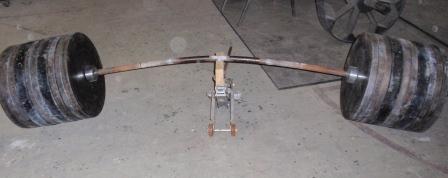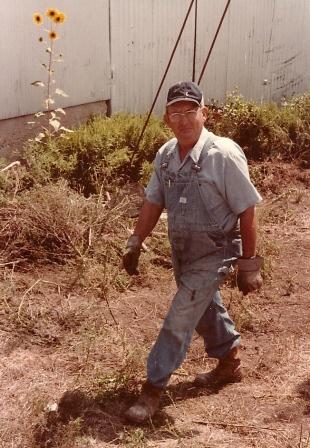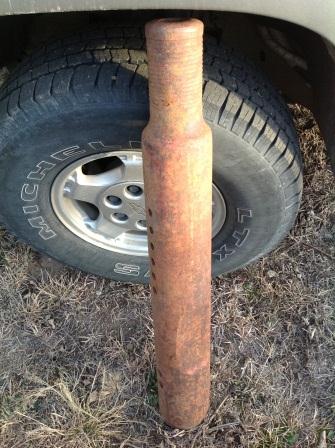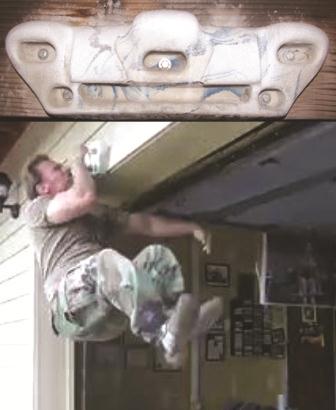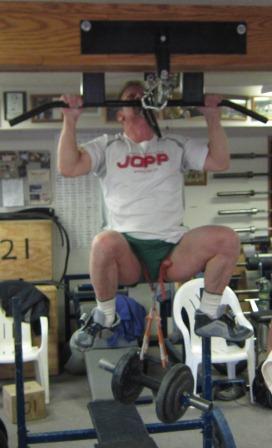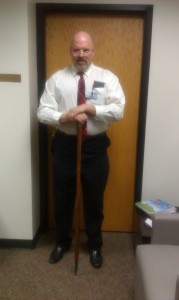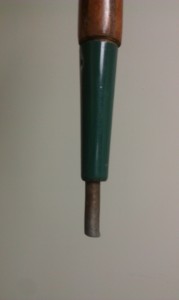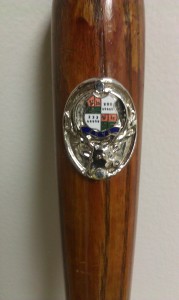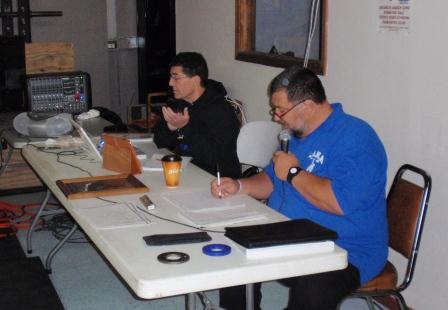How to Evaluate a Lifting Bar
by Al Myers
Most that know me know that I have an passion with lifting bars. I have over 50 bars in the Dino Gym – some excellent high quality bars, some just good bars, and others that are just “run of the mill” bars. I don’t consider myself a collector either, as I use most of these bars in training from time to time.
Most lifters don’t take notice of the bar they are lifting on. It’s just a piece of equipment that is necessary to lift the plates that are on it. There’s nothing wrong with that thinking. After all, the purpose of training is to get stronger and that can be done using anything – including a bad bar. Having HIGH QUALITY BARS for training is not a big determining factor in getting stronger. The bar is just a means to an end result. I’m saying this because I want to make the point that having TOP TIER bars for training are not necessary, they are more just a luxury.
Now how does one evaluate what constitutes a quality bar? There are “hundreds” of bars on the market – with each one having a “sales pitch” behind it. Bars are generally broken into 2 categories:
1. Economy Bars (or Junk Bars)
Economy bars are bars made with cheaper steel, poorer sleeve designs, “looser” quality controls, and are sold at a lower price. I refer to these as “junk bars”. I have several of them by the way. They usually don’t last long though in the Dino Gym, and get bent. But they serve the purpose they are used for, namely exercises that put a bar at “high risk” for damage. Like rack pulls, quick lifts in the rack, one arm lifts, etc. I don’t want to jeopardize a good bar for these exercises as they are not designed for it. I think of “junk bars” as disposable – use them till they bend, then throw them away.
2. Commercial Bars (or High Quality Bars)
This category should be named HIGH QUALITY bars instead, because it is very common for commercial gyms to have economy bars that are “passed off” as a commercial bar. Just put a shiny coat of chrome on a bar and it becomes a “good bar” in most gym-goers eyes. There are many manufacturers of junk bars, but only a few make the top end bars. Don’t always rely on this though, as most manufacturers of high quality bars also have a economy line as well. There are probably over 20 junk bars to every 1 high quality bar sold. If you want to know the difference – just look at the price tag! Cheap bars are “cheap” and high quality bars cost more. You get what you pay for.
High quality bars are made from higher tensile strength steel, sleeves are secured with roll pins or snap rings and contain either bearings or quality bushings, and have better knurling. They are less apt to permanently bend when used. Often high quality bars are often made with a purpose in mind – Olympic weightlifting, general powerlifting, deadlifting, squatting, etc. They are designed for the exercise in question. They often have a good finish – having been zinc plated or a black oxide finish. They are not chrome plated! Factors which influence steel properties are many – combination of alloys, heat treatment procedures, carbon content, etc – I don’t want to get into that in this story as there’s too many other things to talk about. I will keep it simple here and say high quality bars are made with better steel (and it’s not from China!!!).
From now on I’m just going to talk about high quality bars, as junk bars really don’t need evaluated. Terming them “junk bars’ is evaluation enough. I like to break down the evaluation of a high quality bar into these 6 attributes:
1. Strength Rating
2. Dimensions – bar diameter & lengths
3. Sleeve Design
4. Knurling
5. Finish
6. Feel
1. Strength Rating
This is often the NUMBER ONE thing that lifters look at when picking out a bar, and is really just a small factor in the total picture of a high quality bar. Years ago bar manufacturers would promote their product by giving out a Static Rating, a number which was intended to mean the weight the bar could hold before it would bend permanently. The first bar I bought was sold as a 700 lb. test bar. I thought that sounded good – as I wasn’t squatting or deadlifting 700 pounds yet. Well, I bent it with doing explosive squats with 405 shortly after I bought it. Something wasn’t adding up! I then bought another cheap 700 lb. test bar and bent it as well. It was at this time I was studying engineering at Kansas State University and was taking an engineering course, statics and dynamics, that I realized my errors in my thinking. The Static Test in determining this POUND RATING was done entirely different than what I was doing with the bar in the squat rack. In a Static Test the weight is loaded slowly on a bar as its supported, which allows the steel to “conform” to the bend, not under a sudden load as I was putting it under as I was ascending with my squats. Its a Static Rating – not a Dynamic Rating. Add in differences of where the bar is being supported during these Static Tests, and you can see this is a very poor rating system for evaluating bar strengths. You would assume that the bar would be supported in the middle – but I question if that has always been the case in giving out test strength ratings. Moving the supports outwards would increase the Rating. It wasn’t long before most bars went to a 1000 lb. rating, then onto 1500 lbs. and above. After all, a higher Static Rating equated to a better bar and more sales (a marketing fallacy that lifters have “fell for” for years in my opinion).
Now most high quality bars are sold with a PSI Rating of Tensile Strength instead of a Static Rating (even though often you will see both disclosed on a bar). PSI stands for pounds per square inch. This rating is intended to tell you how much force can be applied to a bar before it breaks. This means more to me than a Static Rating because at least you know the force was applied at a set point, ie the middle. The testing involves putting a bar in a press and applying pressure to higher levels, until it snaps. The limitation is still that it is a static force measurement, not a dynamic one as the “real world” bar would be experiencing. But it is a better testing method for determining a bars strength rating than the Static Test. But what lifter really wants to know what PSI it would take break a bar? No one wants to push a bar to THAT LIMIT! I’m more interested in how much force (in PSI) a bar can take and still return to straightness. That is termed Yield Strength – and a measurement that bar manufactures rarely reveal for “who knows why”. Probably because it is a much lower number than Tensile Strength PSI and marketing doesn’t want lifters to mistakenly compare “apples to oranges”, because they don’t know the difference.
2. Dimensions
A bar’s dimensions are very important in evaluating a bar, and these measurements vary significantly from bar to bar. Like I said earlier, most high quality bars are designed with a specific lifting purpose in mind. For example, Olympic weightlifting bars have very different dimensions than a deadlifting bar. Even among Olympic WL bars, these measurements are different. One WL bar may have a diameter of 28mm, and another one may be 29mm. The length between collars may be slightly different as well. The high quality deadlifting bars have a diameter of 27mm, while the high quality squat bars may be 32mm. The marker lines on bars are different as well. Powerlifting bars should have the 32 inch marker line for hand placement, which is NOT the handspacing for Oly lifting. WL bars should have the weightlifting marker lines instead. The standard length for most bars is 7 feet, but some bars are longer (i.e. deadlifting and squat bars). Pay attention to these dimensions when picking out a high quality bar. You want the bar to serve the purpose you intended for it.
3. Sleeve Design
Sleeve designs are different for every bar, but are very important in making a bar a high quality bar. For weightlifting, the sleeves should rotate very smoothly to accommodate snatching and clean and jerks. I have taken apart many bars, and I always marvel at the insides of bar sleeves. This is the part of the bar no one ever sees. I enjoy taking sleeves apart, and I think of it as doing an autopsy on a bar (which it usually is as the bar was previously “killed off” and bent, thus the reason I was disassembling it). There are many ways sleeves are designed to enhance rotation. This is what I have seen, from worse to best: 1. metal on metal, 2. plastic bushings, 3. nylon bushings/brass bushings, 4. ball bearings, & 5. needle bearings. That pretty much sums it up. Needle bearings have long been considered the “gold standard” – but I can tell you there are differences there as well. I’ve taken apart several junk bars that I’m surprised they rotate at all, as all they contain is a couple of worn cheap plastic bushings – yet are marketed as having bushings. These type of bushings shouldn’t even be called bushings as they are so inferior to the quality bushings (like nylon and brass) high quality bars have. The diameter of the sleeves should always be checked. Most high quality bars have sleeves that are very close to 2″ (sometimes as much as 1-31/32″). If your plates are high quality as well (and in turn have close tolerances for the bar hole), the bar may not fit well in some plates. The reason for this is that at the “top end” the bar is made for the plate being used, and BY THE SAME MANUFACTURER. The Manufacturer makes the bar and plates as a set to “go together” with close tolerances, so the plates won’t be “sloppy” on the bar. The way the sleeve is held onto the bar also tells alot about the quality. You can quickly spot a low quality bar if the sleeve is held on by a bolt in the end. This is the cheapest and easiest way to hold the sleeve on, but this bolt never seems to stay tight and requires constant attention so the sleeve doesn’t fall off! This design allows lateral sleeve movement on the bar, which is undesirable. It gets worse with wear. The “high end” bars use snap rings or roll pins. A few use both. The best design is using snap rings, as they are concealed and very rarely fail (yet I have seen it happen, but only when the bar was used in an unconventional matter).
4. Knurling
Every bar has its own unique knurling. I think of knurling as the “fingerprint” of a bar. It defines the bar and makes it different from other bars. Most people think knurling is cut into a bar, but that is false, as knurling is actually done by a pressing process. There are many different “setups” for knurling, with each one giving a unique knurl. Some are deeper, some wider, different patterns,etc. The purpose of having knurling is to enhance your grip on the bar, without causing damage to your hand. Different lifters have different preferences on the “aggressiveness” of the knurl. The spacing of the knurling is different as well. Some bars have center knurling, while others don’t .
5. Finish
The top choices for a bar finish are these: 1. none or blued, 2. Chrome plated, 3. Zinc plated, and 4. Black oxide. If you are fortunate to have a stainless steel bar you have a bar that DOES NOT need a finish. The stainless steel stays looking good always! I have one Stainless Steel Bar, that I have had for over 5 years, and it has NO rust or corrosion on it. It looks as good now as when I bought it. However, stainless steel is very expensive (3 to 5 times that of other steel), and is difficult to machine which makes these bars prohibitively expensive. That’s why you don’t see them much. Chrome plating is the standard of economy bars because it’s the lowest cost way of keeping a bar shiny. That’s what you see on bars in commercial gyms, as they can be wiped clean after usage and remain with a glossy finish. I actually hate chrome plated bars – they are harder to grip, the chrome often starts to flake off after heavy use, and the chrome doesn’t hold chalk well. Zinc plating has become more common recently. At first glance you might think a Zinc plated bar was chromed, but you can tell the difference if you see both of them side by side. Black oxide is also a very common bar finish. I really like this finish as these bars hold chalk well and the knurling is not coated with chrome or zinc and has a better feel. Now there are also a few high quality bars that have no finish (or maybe just a bluing). You can spot these in the gym because they are rusted and look like crap. But that doesn’t bother me getting a little rust on my hands if the bar is a great bar otherwise! I have one of these in the gym (I won’t name it!) that is one of my favorite bars. You have to remember that a finish is put on a bar for only one reason – to make it look better. It provides no benefit to the functionality or performance of the bar, and I’ve talked to several lifters that prefer the feel of the “natural steel” over that of a bar with a finish.
6. Feel
Now this is the intrinsic category. No measurements or processing procedures here to make an evaluation. It comes down to answering this question,”how does the bar feel in your hands when you lift on it?”. Do you like it? Or does it just don’t feel right? A bar may look like the “bar of your dreams”, but when you load it up to a heavy weight and perform a lift, does it feel as good as it looks? I’ve been disappointed before with a new bar. There are several factors that make bars feel different. The biggest one is “bar deflection”. This is the bend that occurs when the bar is moved or accelerated during a lift. It is purely a result of the steel properties of the bar, and is different for every bar. Some bars deflect more, while others are stiffer when lifting on. The bar diameter and ratings may tell you a little on this, but it comes down to the steel used. I say this because I have bars that have the same diameters and ratings, yet deflect (or bend) differently when lifted on. As well, each lifter has their own preference. The same goes for “bar oscillation”. This is sometimes referred to as whip. It occurs when the bar is deflected during acceleration of a lift, and then the movement of the bar is ceased. The oscillation will continue upwards. Some bars will deflect, then return to position quicker than others and have less oscillation. Others will tend to oscillate, which can be viewed as favorable or not, depending on the lifter and how they can adjust to it. Sometimes it can be used to the lifters advantage, as often seen in the clean when rebounding from the catch to the squat. Sometimes “the feel” is purely psychological with a bar. I have a couple of bars that are my “go to” bars when I want to get a big lift in for the workout. I’ve had success with them in the past – and this confidence is propagated into future success. The question is answered – the bar just feels good in my hands when I lift on it!
I hope all this helps in understanding how to evaluate a lifting bar. I apologize for getting so long with all this – which I guess goes to show that I may be beyond passionate on this subject and bordering on obsessive/compulsive. I’m going to cover a few of the bars in the Dino Gym over the next couple of months in USAWA Daily News stories. Several of the Dino Gym bars have interesting stories that go with them. and I want to share this with you.
And to answer the question in BAR BENDING:101 – that poor bar was never straight again!
